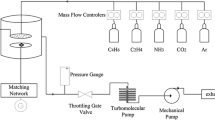Abstract
The surface treatment of different polymers and their corresponding model surfaces in the flowing afterglow of an oxygen microwave plasma is investigated. The concentration profiles of tire long-lived species issued from the plasma are measured and calculated in the downstream area The influence of atomic and singlet molecular oxygen in the behavior of different polymers is investigated. It appears that the evolution of the surface energy can be explained by an initiation of the functionalization by the oxygen atoms impinging upon the surface followed by reaction of the radicals formed with molecular oxygen. The concentration of functions at the sureface is limited due to their destruction by reaction with oxygen atoms. Furthermore, the functionalization level is higher in the /lowing afterglow than in the plasma, without any significant degradation of the polymer surface. Therefore, the treatment in the flowing afterglow is more efficient to increase suface energy in particular, for polymers which undergo high backbone chain scission.
Similar content being viewed by others
References
H. Biedermann and Y. Osada,Adv. Polym. Sci. 95, 57 (1990).
H. V. Boenig, inFundamentals of Plasma Chemistry and Technology (Technomic Publishing Company Inc., Lancaster, Pennsylvania, 1988).
F. Poncin-Epaillard, B. Chevet, and J-C. Brosse,Eur. Polym. J. 3, 333 (1988).
M. A. Golub, T. Wydeven, and R. D. Cormia,Polymer 30, 1571 (1989).
R. Foerch, N. S. McIntyre, R. N. S. Sodhi, and D. H. Hunter,J. Appl. Polym. Sci. 40, 1903 (1990).
R. Foerch and D. Johnson,Surf. Interface Anal. 17, 847 (1991).
F. Clouet and M. K. Shi,J. Appl. Polym. Sci. 46, 1955 (1992).
A. Granier, S. Pasquiers, C. Brosse-Laporte, R. Darchicourt, P. Leprince, and I. Marec,J. Phys. D 22, 1487 (1989).
F. Clouet, M. K. Shi, R. Prat, Y. Hoff, P. Marie, D. Léonard, Y. De Puydt, P. Bertrand, J. L. Devez, and A. Doren,J. Adhesion Sci. Technol. 8, 329–361 (1994).
S. Wu,J. Polym. Sci., Polym. Symp. 34, 19 (1971).
G. Gousset, P. Panafieu, M. Touzeau, and M. Vialle,Plasma Chem. Plasma Process. 7, 293 (1987).
S. Hadj-Ziane, B. Held, P. Pignolet, R. Peyrous, J. M. Benas, and C. Coste,J. Phys. D 23, 1390 (1990).
P. H. Vidaud, R. P. Wayne, and M. Yaron,Chem. Phys. Lett. 38, 306 (1976).
D. Baulch, R. Cox, P. Crutzen, R. Hampson, I. Kerr, J. Troe, and R. Whatson,J. Phys. Chem. Ref. Data 11, 327 (1982).
B. Eliasson, Brown Boveri Report KRL83-40C,Electrical Discharge in Oxygen, CH-5405 Baden, Switzerland (1983).
A. Granier, inMicrowave Discharges: Fundamentals and Applications (Plenum Press, New York, 1993), pp. 491–501.
D. C. Astholz, A. E. Croce, and J. Trive,J. Phys. Chem. 86, 696 (1982).
J. E. Frederick and R. J. Cicerone,J. Geophys. Res. 90, No. D6, 10733 (1985).
P. N. Pokholak, P. M. Vohlyaev, O. N. Karpukhin, and S. D. Razumovskii,Vysokoniol. Soedin. B 11, 692 (1969).
R. L. Sharpless, L. E. Jusinski, and T. G. Slanger,J. Client. Phys. 91, 7936 (1989).
R. L. Sharpless, L. E. Jusinski, and T. G. Slanger,J. Chem. Phys. 91, 7947 (1989).
A. Höllander, I. Behnish, and H. Zimmermann,J. Appl. Polym. Sci. 49, 1857 (1992).
P. Andersen and A. C. Luntz,J. Chem. Phys. 72, 5842 (1980).
J. Petruj and I. Marchall,Radiat. Phys. Chem. 16, 27 (1980).
M. K. Shi, J. Christoud, Y. Holl, and F. Clouet,J. Macromol. Sci., Pure Appl. Chem. A30, 219 (1993).
R. E. Huie and J. T. Herron,Prog. React. Kinet. 1, 157 (1975).
F. Clouet and M. K. Shi,J. Appl. Polym. Sci. 46, 2063 (1992).
B. Ranby and J. F. Rabek, inPhotodegradation, Photo-oxidation, and Photostabilization of Polymers (Wiley-Interscience, New York, 1975), pp. 120–141.
Author information
Authors and Affiliations
Additional information
Died April 27, 1993.
Rights and permissions
About this article
Cite this article
Normand, F., Granier, A., Leprince, P. et al. Polymer treatment in the flowing afterglow of an oxygen microwave discharge: Active species profile concentrations and kinetics of the functionalization. Plasma Chem Plasma Process 15, 173–198 (1995). https://doi.org/10.1007/BF01459695
Received:
Revised:
Issue Date:
DOI: https://doi.org/10.1007/BF01459695




